The move into all-grain brewing can be a daunting task, which is why the new all in one electric beer brewing systems have become so popular in recent years. They are easy to set up, highly space efficient, have a super quick brewing time, and you can learn to brew like a pro with almost no experience.
The main barrier for many home brewers is the price tag: which all in one brewing system is right for you, and what is a fair price? In fact, out of the top three, which overall is the best home beer brewing system?
Today, I’m comparing the top three electric beer brewing systems so you can decide which best matches your budget and all-grain brewing requirements.
1) The Grainfather
The Grainfather is the best entry-level all in one brewhouse. It has a relatively low price tag being the cheapest of the Big Three. It is also the most hands-on of the three, requiring a bit more attention and manual operation, which some people may actually prefer.
Automation: Most manual
Extract Efficiency: Most efficient
Inclusions:
- Wort Chiller
Optional Extras:
- Sparge Water Heater
- Hood for distillation or water purification
Who should buy this?
The Grainfather suits anyone on a budget who does not mind a bit of hands-on brewing. It has all the benefits of making brewing easy for beginners and is a time-saver for experienced home brewers who have been using DIY brewhouses.
Who should not buy this?
If you are time-poor or looking for a truly automatic system, you should spend the extra money to get a Braumeister or a PicoBrew Zymatic.
Best Place to Buy:
- For a Grainfather in the USA, click here
- For a Grainfather anywhere else, click here
Need more information on the Grainfather? Read the full review here.
2) Speidel Braumeister
The Braumeister is possibly the most well-known all in one brewing system. It features a German engineering and brewing tradition combined, with great automation and a range of sizes to choose from.
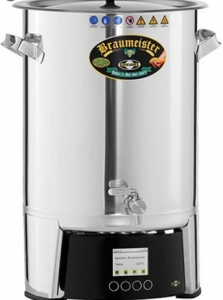 Cost: Around $1,800 for the 20 liter model (Medium)
Cost: Around $1,800 for the 20 liter model (Medium)
Automation: Medium
Extract Efficiency: Lowest
Inclusions:
- Just the unit itself
Optional Extras:
- All the brewing tools you can think of
- Alternate sizes: 50 liter, 200 liter, and even a 500 liter model for microbreweries.
Who should buy this?
The Braumeister is a complete beer brewing system, but there are a few points where you will need to be involved during brew day, but much of the process is automated and easy – you won’t even need to stir! At the price tag of $1,800, this makes it a little steep, but a good option for most dedicated home brewers.
Who should not buy this?
If you really need to stick to a budget, you should consider the Grainfather, which is almost as good. On the other hand, if you really need your system to run by on its own while you do other things, the PicoBrew Zymatic is for you!
Best Place to Buy:
- For a Braumeister in the USA, click here
- For a Braumeister anywhere else, click here
Need more information on the Speidel Braumeister? Read the full review here.
3) PicoBrew Zymatic
The most automated brewing system on the homebrew market today. It’s compact, runs through a brew day in 4-5 hours, and once it’s set it up you only need to come back to configure the cooling system and add the yeast. On the other hand, it’s the most expensive electric beer brewing system and has the smallest batch size.
Automation: Best
Extract Efficiency: Medium
Inclusions:
- Heat exchanger
- Custom fermenter
- Connection to online resources and automation control software
Optional Extras:
- Extra custom fermenters
Who should buy this?
If you have spare cash but you don’t have spare time, this unit is absolutely perfect. It is also the best option for use as a pilot brew system in your brewery, as you can set and forget a test batch while you run your primary brew house.
Who should not buy this?
If you don’t have $2,000, you can still make great beer with a Grainfather and just take a little more effort per brew day. You could also consider one of the other options if you want more control over the brewing process – the PicoBrew Zymatic demands full control of your brew.
Best Place to Buy:
- For a Zymatic in the USA, click here
- For a Zymatic anywhere else, click here
Need more information on the PicoBrew Zymatic? Read the full review here.
So here you have the best of the best of brewing systems available. I have reviewed each in detail; you can find them on my reviews page and decide which of them suits you best. My personal choice, as a professional brewer, is the PicoBrew. I can set this baby up while my full-size mash is going and come back during the boil or the cooling stage to finish it off.
My suppliers of choice for the best prices are Adventures in Homebrewing, who offer shipping to the USA and international locations, and Amazon, who are a great international supplier. Don’t delay, as these machines frequently sell out!
CHEERS!
Thank you for reading my comparisons of these awesome pieces of hardcore beerography! If you have any questions about any of them, please leave it in the comments and I will get back to you ASAP.
Read next: Finding the Best Beer Koozies for Bottles And Cans: What’s on Amazon?, 7 Easy Ways To Add Personalization To Your Beer Koozies, How to Filter Beer and The Science Behind Beer Koozies: How They Keep Your Beverage Cold!




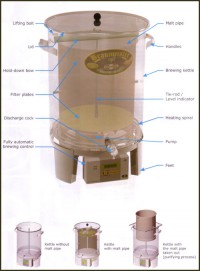
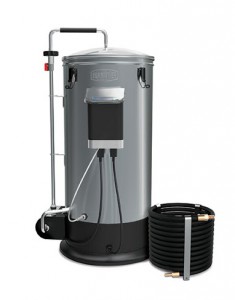
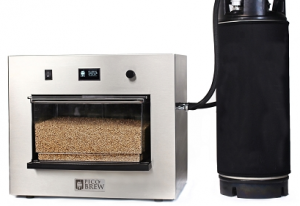
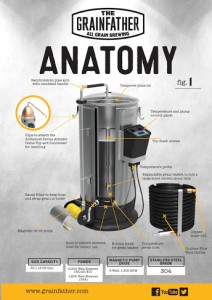
I really like all of them. I think you have done a great job with the preview. It’s perfectly detailed and very nice.
It’s great that you’ve helped us decide which one is best for us. I have been looking at these three and thought ”I have no idea which one is best for me”. With your help i know which one is best for me.
Thanks Daniel!
Out of interest, which one did you choose, and what was the deciding factor?
Cheers 🙂
Hi, I have never heard of this way of brewing beer before. For years I have thrown all the ingredients into a vat and let them ferment away for a week before bottling. How do these electric brew systems work to speed up the process? Do they do away with natural fermentation?, cheers Jamie
Hi Jamie,
These systems are for brewing from all grain – it will always take longer to brew an all grain recipe than a “kit beer” recipe, but these electric brewing systems are the fastest method of all-grain brewing.
I hope that helped answer your question!
I haven’t done any home brewing since my college days but have always kept a keen interest in beer. Particularly in drinking the stuff!
This is a system that I was vaguely aware of but hadn’t given much thought to it previously. It seems to me that these type of systems are straightforward and quite easy to use.
How long would I have to wait from the beginning of the process to actually pouring and enjoying my beer?
Good question.
It will take as long as any other system in terms of fermentation and cellaring time. Depending on the style of beer, you could be drinking it within 3 weeks.
These systems are great for reducing the time taken to complete your brewday, especially the PicoBrew. To reduce fermentation and cellaring times, try using Conical Fermenters and a Kegerator system.
Cheers!
I love this comparison! It is surprising how much the price varies from model to model. I’m wondering what steps you are saved from doing by buying the automated beer brewing system. I am allergic to many beers and I wonder if I could brew my own that I wasn’t allergic to. Is there any way to brew a beer that would contain absolutely no sulfites? Or maybe there is a way of removing sulfites?
Hi Christina,
You can choose all-natural beers to eliminate added sulfides during filtration. However, Di-Methyl Sulfide (DMS) is produced in all beers during the brewing stage. This is largely removed due to evaporation during the boil, but depending on your level of sensitivity it may be best to give beer a miss altogether.
If you do want to try brewing your own, stay away from the PicoBrew – The Grainfather and Braumeister have stronger boil / evaporation than the PicoBrew.
I hope that helps!
Hello, and greeting form the UK. firstly thansk for the comparison – very useful, although i am still not sure which ones best, or if a Brew in the bag might be best for a begginer. one big question though – what produces the best tasting beer- is there an actual taste/quality difference or are the differences merely labour saving, my priority will be trying to make the best tasting beer possible( alll be it as a begginer).
my thinking is automated is usefull as it means less chance for me to make mistakes i guess and allows me to focus more on the experimenting with the recipe side of things. That said i have no problem with a bit of hands on as long as it simple, as i am a keen cook, so interaction can be part of the fun.
Hi Robbo, salutations from Australia / Japan / China!
You can make great tasting beer with any equipment – your fermentation and sanitation practices will play a huge role too. For brewhouse gear (the stuff that deals with hot liquid) the main differences are level of control, accuracy, ease of use, cleanliness, footprint (size) and – the big one – efficiency of extract. Efficiency relates to how much sugar you get from the grain, and has several major factors.
A good starting point is the Igloo Cooler – you can read up on it here or head over to howtobrew.com to learn about building one yourself (takes a while to build the first time!)
I’m a seasoned, serious, demanding, successful home brewer. I have all the equipment, but I long for a system that can do small batches as I hone in on specific targets – it pains me to make a 7 gallon batch (smallest practical batch I can do) and dump most of it because it’s a progression to what I want, rather than what I want. You say the Zymatic has a “very limited range of brewing techniques” – can you explain that a little more? I’ve done decoction mashes and find them fascinating and even fun – but, frankly, a complete waste of time and effort with modern malts. All I need is the ability to be able to set the temperature of a single-step infusion mash; mash-out is nice, kind of expected, but I actually think it’s probably over-rated – nonetheless, I’d like to know if it has that capability. And up to four hop additions? I can say when to add? More than enough for me. I’m a little concerned about your comments on low-energy boil and DMS, but as long as it drives off enough DMS to avoid flavor distractions it’s not a problem for me. I don’t mind fermenting in/racking from a keg, but can a reasonably enterprising home brewer figure out a way to use another fermentation vessel? Small batch limitation? No problem (actually, for me it;s a benefit). Keg a necessity? No problem. I’m just concerned about the limitations of technique. Thanks for your thorough and thoughtful reviews.
Excellent set of questions. Let me try to keep answers simple and easy:
– Limitations: I was referring mainly to decoction mashes and also strong beers.
– Hop additions: Yes, you can choose when they occur. The hops are kept in little individual compartments, then added according to a pre-set time which you will specify at the start of the brew day.
– So far I have not had a Picobrew batch with high DMS, but I still wonder if it might happen one day.
– A reasonably enterprising homebrewer can figure out how to turn a tree trunk into beer. You should be fine 🙂
Get one here: Homebrewing.org
Thanks John!
Hi Jesse, I’m just looking at investing in one of these systems and was wondering which system has the best forums for recipes to try out on that system. Is there a Grainfather forum that you can join where recipes are discussed and swapped? Is the Grainfather forum better than the Braumeister forum?
Hi Sean,
I tend to stay off the forums due to some extreme differences of opinions (usually there is more than one correct approach to any brewing topic, by the way.) What I do know is, you can run most recipes on either system. If you are looking for open source recipes, try Brewer’s Friend (click here) or grab some recipe books (click here).
I hope that helps!
Cheers,
Jesse
Anything like the GrainFather that can brew a 10 gal batch of beer??
Hi Danny,
The closest that I know of would be the Braumeister 50 litre model – check it out here: